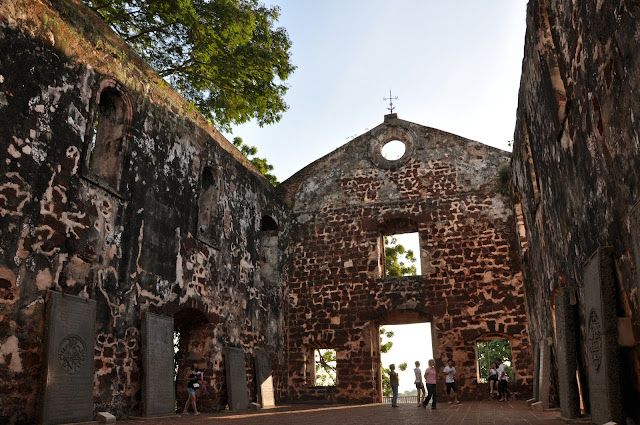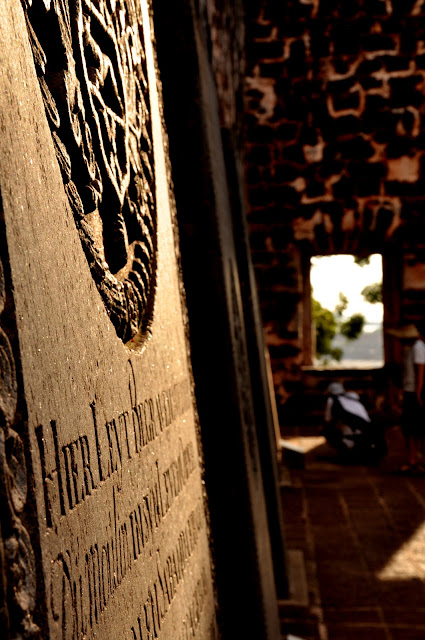As you make your way to St Paul Church located at the St Paul Hill, it may take you some time, just a little bit longer than you would expect. It is not an easy climb even for my two kids !
At the summit of St. Pauls Hill stood a historical monument built by Duarte Coelho, a Portuguese Captain in 1521 AD, the church was formerly a chapel for the Portuguese and it was named as “Nosa Senhora” – translated as "Our Lady of the Hill". Although these valuable ruins have been standing on top of the summit of St. Paul Hill in Melaka for centuries, the strong and thick bricks still remind one of the magnificence architecture of the 16th century.
In front of the church stood a huge pearl-white statue - the status of St. Francis Xavier. 27 years after Duarte Coelho built the church, Don Albuquerque, the Archbishop of Goa in India handed the church to the Society of Jesus. St. Francis Xavier, as the pioneer Catholic Missionary that time was appointed to receive the title on behalf of the society in 1548.
The statue was built in 1952 in order to commemorate this saint. However, many are curious about the missing right arm of the statue (seen above). The statue was not being constructed without the right arm on purpose. The completed statue was planned to be consecrated in the morning. However, a tree fell and broke off the statue’s right arm. Until today, the statue that stood in front of St. Paul Church has a missing right arm.
When you visit St. Paul Church, you will discover more than what you expected. Standing on the hill, what you see is not merely St. Francis Xavier statue, the church with thick brick or the Dutch monumental tombstones. What exist here are the unique blend of history and culture, a chapel built by a Portuguese captain, being handed to the Society of Jesus and later renamed by the Dutch. All these become what we see today.
At the summit of St. Pauls Hill stood a historical monument built by Duarte Coelho, a Portuguese Captain in 1521 AD, the church was formerly a chapel for the Portuguese and it was named as “Nosa Senhora” – translated as "Our Lady of the Hill". Although these valuable ruins have been standing on top of the summit of St. Paul Hill in Melaka for centuries, the strong and thick bricks still remind one of the magnificence architecture of the 16th century.
As Melaka was colonised by the Dutch from the hand of Portuguese in 1641, the fate of this former Portuguese chapel had been significantly changed. It was being used by the Dutch as a temporary praying place before their own church – which is the Christ Church was being completely constructed. Since that, the Dutch has renamed the Portuguese Chapel from “Nosa Senhora” – translated as "Our Lady of the Hill to St. Paul Hill".
When the Dutch’s Christ Church was completed, St. Paul Hill no longer played its role as a praying place and the Dutch then turned it into a burial ground and graveyard. In the interior walls of the chapel, you can see several monumental tombstones, with Dutch words engraving on it were leaning against the wall of the church. The tombstones and the graveyard nearby were places for the Dutch to mourn their ancestors while they settled down in Melaka centuries ago.
The statue was built in 1952 in order to commemorate this saint. However, many are curious about the missing right arm of the statue (seen above). The statue was not being constructed without the right arm on purpose. The completed statue was planned to be consecrated in the morning. However, a tree fell and broke off the statue’s right arm. Until today, the statue that stood in front of St. Paul Church has a missing right arm.
When you visit St. Paul Church, you will discover more than what you expected. Standing on the hill, what you see is not merely St. Francis Xavier statue, the church with thick brick or the Dutch monumental tombstones. What exist here are the unique blend of history and culture, a chapel built by a Portuguese captain, being handed to the Society of Jesus and later renamed by the Dutch. All these become what we see today.






